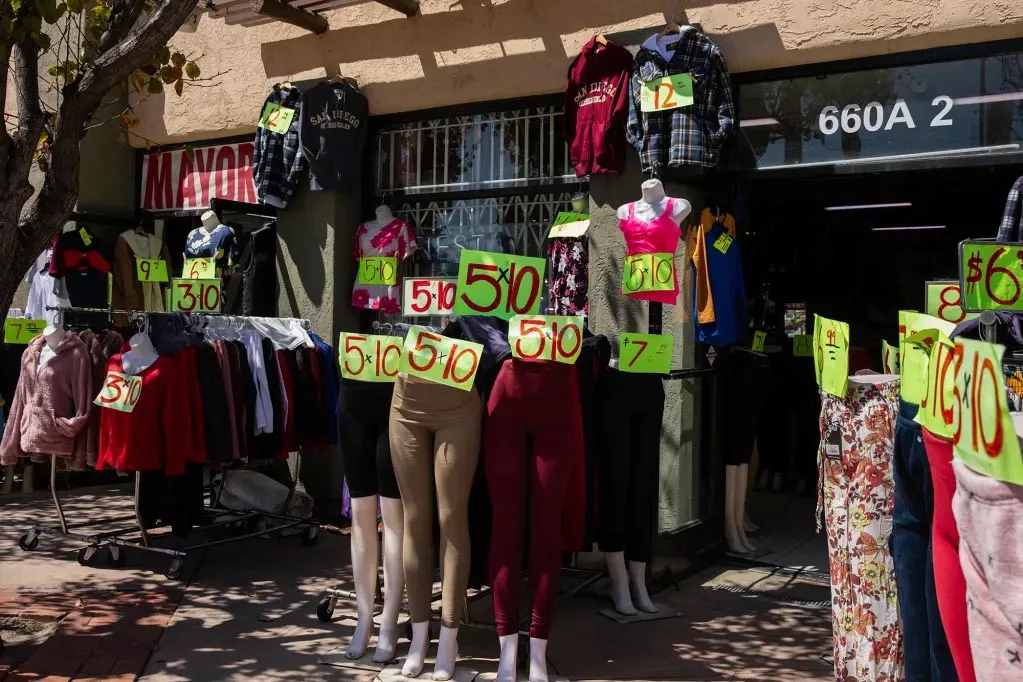‘Prolonged’ wait times at the Mexico border are putting a strain on small businesses in California

Government agencies are investing significant funds to improve wait times at the U.S.-Mexico border, but the checkpoints remain heavily congested, impacting border communities. In recent months, queues at the border have frequently extended for hours, frustrating over 150,000 individuals, including students, cross-border families, healthcare workers, and small business owners, who cross the border daily. Experts note that some border residents have reduced their crossings, leading to substantial sales losses for small businesses due to decreased foot traffic in the region.

“Money can be replaced, but time is irreplaceable. People are wasting their time in those lines,” commented Sunil Gakherja, a 49-year-old owner of a small perfume store in San Ysidro, a neighborhood in San Diego near the border.
U.S. border officials highlight the necessity of reallocating resources to manage irregular migration, referring to individuals who enter the United States at locations other than official ports of entry, typically to seek asylum. San Diego has surpassed Tucson this month as the busiest sector for the Border Patrol nationwide.
However, residents and business leaders in border areas argue that the federal government should adequately staff the border to ensure that the $741 million expansion of the San Ysidro Port of Entry achieves its intended goals of reducing wait times and boosting the regional economy.
Research conducted by the Atlantic Council suggests that a 10-minute reduction in wait times could result in an additional $26 million worth of cargo entering the United States monthly, with an annual economic impact of $5.4 million from purchases made by families and individuals entering the U.S. from Mexico.
However, in the San Diego region, regular border crossers report that wait times are increasing rather than decreasing. Previously, waits of 30 minutes to an hour on weekdays now regularly extend to three to four hours. Pedestrians endured waits of six hours or more on several days last December. Additionally, long lines extend southbound into Mexico, further exacerbating the situation. Kenia Zamarripa, vice president of international and public affairs at the San Diego Regional Chamber of Commerce, described the waits on both sides of the border as “devastating.”
“This is families losing their incomes,” she stated. “There are 800 small businesses in San Ysidro that depend on pedestrian crossings, and 90% of their customers cross on foot.”

State officials noted that it is unclear how much California has lost in sales tax revenue due to the inability to break down this information by zip code.
Andrea Alaniz, whose mother owns the El Rincon restaurant in San Ysidro, shared that after its 2017 opening, the restaurant encountered the typical challenges and growth hurdles faced by many small, family-run businesses. Located along San Ysidro Boulevard, a few blocks from the border, the Mexican food restaurant relied on Alaniz and her family to handle all aspects of the operation, from cooking to serving tables, in the hopes that business would grow steadily.



The restaurant quickly gained popularity for its homemade family recipes from Guadalajara, Jalisco, known as caseros. The delicious food drew long lines, with some customers traveling from Los Angeles or crossing north from Baja California for a taste. Alaniz attributes the unique taste of their dishes not just to the spices but also to her mother’s exceptional cooking skills and the longstanding family recipes.
As the business flourished, the entire family, including Alaniz and her four siblings, joined forces to manage the increased volume and success. Their efforts paid off, creating a lively and enjoyable atmosphere at the restaurant.
However, the COVID-19 pandemic brought a significant setback. Federal travel restrictions severely limited cross-border travel, causing a sharp decline in business. Approximately 200 businesses in San Ysidro, a community of about 25,000 people, primarily consisting of working-class immigrants, were forced to close permanently, according to Jason Wells, president of the local chamber of commerce.
Despite the challenges, Alaniz and her family managed to keep El Rincon open and even sent money to relatives in Mexico. However, the decrease in cross-border traffic significantly impacted their business. “We just don’t get the same amount of people coming in, because people aren’t going back and forth anymore,” Alaniz lamented.
Numerous studies indicate that immigrants, like Alaniz’s family, played a crucial role in the United States’ economic recovery from the pandemic. According to an analysis by the Economic Policy Institute of federal data, approximately 50% of the recent growth in the labor market came from foreign-born workers between January 2023 and January 2024.
Zamarripa expresses concern that border communities lose around $2 billion annually due to long border wait times. She fears that the current bottlenecks at checkpoints could significantly impact those striving to recover.
Gakherja, the perfumery owner, recounted the story of a customer who waited six hours to cross the border on a Sunday.
“He got in line at 9 in the morning and arrived here at 3:30 p.m. It’s too much. Imagine they have kids who need to use the restroom. They need food. They’re not thinking about shopping after that,” Gakherja remarked.
Waiting is the most challenging aspect
The impact of backlogs at inefficient ports of entry isn’t limited to small businesses. The hardest-hit are the region’s hospitality and healthcare workers, students, medical patients, and anyone relying on the interdependence of a cross-border region to offset the high cost of living in San Diego, one of the nation’s most expensive cities.
Hector Urquiza, a 19-year-old college student serving in the Army Reserves, resides with his brother in Tijuana due to the high rent in San Diego.
“When I had to go to work, there was a two-hour line. It was like a snake, you know, wiggling around. That was kind of painful,” Urquiza shared.
Cross-border travelers often use Facebook to document their experiences and wait times because official Customs and Border Protection data is considered inaccurate and unreliable. Cómo está la línea Tijuana (How is the Tijuana line), a Facebook group with 430,000 members, was established in June 2013 when its creator relied on official CBP wait times and was significantly late for work, according to his posts.
Urquiza mentioned that regular border crossers develop a system, which sometimes involves holding a spot in line for each other to reduce their daily commute. However, Tijuana authorities have recently cracked down on this practice, making it more challenging to navigate the school or work week.
Numerous studies indicate that immigrants, like Alaniz’s family, played a crucial role in the United States’ economic recovery from the pandemic. According to an analysis by the Economic Policy Institute of federal data, approximately 50% of the recent growth in the labor market came from foreign-born workers between January 2023 and January 2024.
Zamarripa expresses concern that border communities lose around $2 billion annually due to long border wait times. She fears that the current bottlenecks at checkpoints could significantly impact those striving to recover.
Gakherja, the perfumery owner, recounted the story of a customer who waited six hours to cross the border on a Sunday.
“He got in line at 9 in the morning and arrived here at 3:30 p.m. It’s too much. Imagine they have kids who need to use the restroom. They need food. They’re not thinking about shopping after that,” Gakherja remarked.
Waiting is the most challenging aspect
The impact of backlogs at inefficient ports of entry isn’t limited to small businesses. The hardest-hit are the region’s hospitality and healthcare workers, students, medical patients, and anyone relying on the interdependence of a cross-border region to offset the high cost of living in San Diego, one of the nation’s most expensive cities.
Hector Urquiza, a 19-year-old college student serving in the Army Reserves, resides with his brother in Tijuana due to the high rent in San Diego.
“When I had to go to work, there was a two-hour line. It was like a snake, you know, wiggling around. That was kind of painful,” Urquiza shared.
Cross-border travelers often use Facebook to document their experiences and wait times because official Customs and Border Protection data is considered inaccurate and unreliable. Cómo está la línea Tijuana (How is the Tijuana line), a Facebook group with 430,000 members, was established in June 2013 when its creator relied on official CBP wait times and was significantly late for work, according to his posts.
Urquiza mentioned that regular border crossers develop a system, which sometimes involves holding a spot in line for each other to reduce their daily commute. However, Tijuana authorities have recently cracked down on this practice, making it more challenging to navigate the school or work week.
“When commuters spend hours waiting in border traffic, business productivity across Southern California suffers,” local leaders assert.

